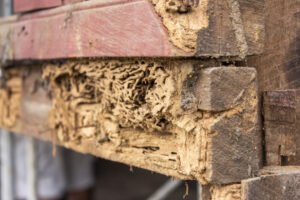How Do Termites Cause So Much Destruction to Homes?
Termites cause so much destruction to homes because they are active 24/7. Termite colonies and their inhabitants never sleep. This means workers are constantly gathering food, digesting it, and sharing it with termite soldiers and the queen. On top of this, termite queens constantly lay new eggs that will develop into new termite workers and soldiers.
In other words, the colony is so active that by the time homeowners discover they have a termite problem and schedule termite treatment, the damages are often significant. In fact, termites cause billions of dollars of damages to homes throughout the United States every single year.

What Type of Wood Do Termites Eat?
A common misconception many people have is that termites strictly eat the dry wood used to build the internal support structures of homes. However, this is a myth. The type of wood termites eat is largely based on their species.
For instance, drywood termites prefer dry wood, like the wood used to build your home. On the other hand, dampwood termites won’t eat dry wood. Instead, they seek out sources of moist, damp wood, like found outdoors, such as:
Unprotected Firewood Piles
Dead Trees
Tree Stumps
Even subterranean termites have their own wood preferences. This species tends to like softwoods and softwood fibers. Common softwoods include pine, redwood, cedar, spruce, and juniper.
What Do Termites Eat Besides Wood?
Another common myth people have is that termites will only eat wood. This is not true at all. Rather, all species of termites require cellulose, an abundant organic compound found in wood and a wide range of plants and vegetation. Cellulose is the primary food source all termites need in order to survive.
Cellulose can be found in:
Trees
Lumber
Drywall
Hardwood/Laminate Flooring
Cabinetry
Countertops
Cardboard
Paper
Books
Leaves
Cotton Clothing
This is why termite infestations inside homes can extend beyond the wooden structures that support the house. Termites can destroy kitchen and bathroom cabinets. The will also eat and destroy hardwood and laminate flooring. In extreme infestations, termites have been found tunneling through books.
Are Termites Beneficial in Any Way?
While termites can be a headache for homeowners, they do provide a valuable service in nature. In these types of environments, termites aid in the breakdown and decomposition of dead, dry, or damp wood. They help ensure dead trees, shrubs, and other such vegetation is broken down. Essentially, they are assisting in making nutrient-rich soil.
How Can I Protect My Home?
There are several things you can do around your home to help reduce the risks of termite infestations, including:
Do not use wood mulch around the exterior of the home.
Do not store firewood on the ground or next to the home.
Do not store cardboard boxes, old newspapers and other paper-based products in your garage or storage shed.
Have your home inspected annually for
Use the appropriate treatments to keep termites in nature, where they belong, but not inside your home.
To help protect your home against termite infestations, you need to have a detailed inspection completed, along with the right termite treatment services. Please feel free to contact MightyMite Termite Services at 408-377-3761 now to schedule an appointment!
